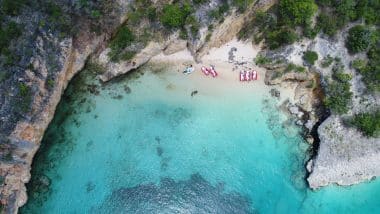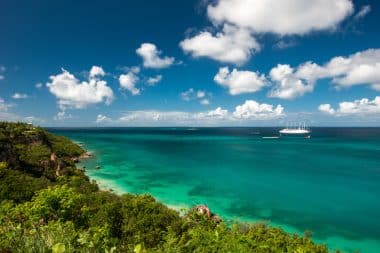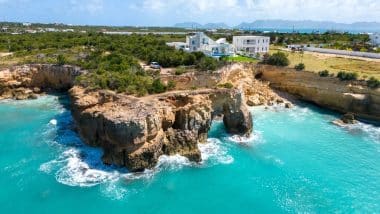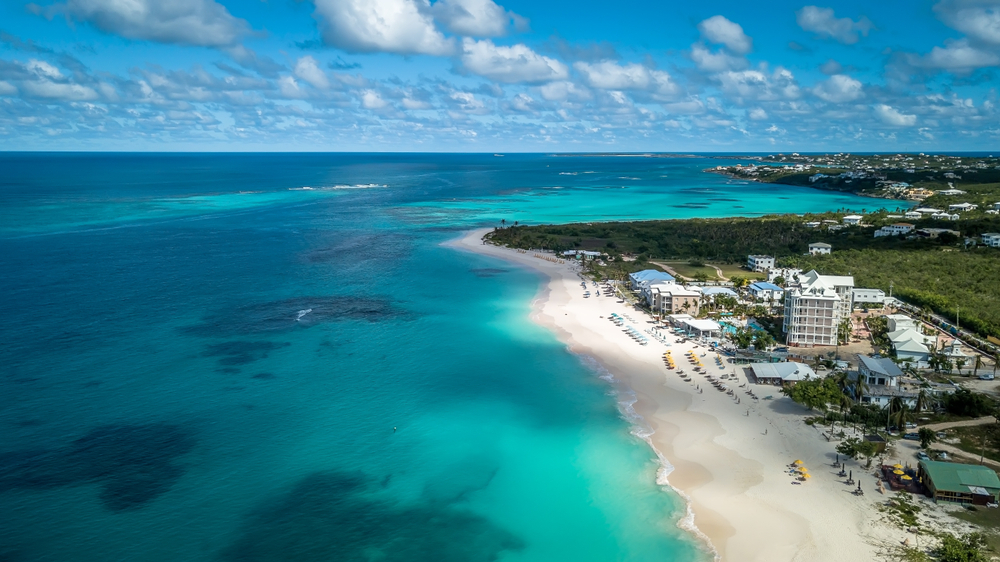Anguilla belongs to the archipelago of the Lesser Antilles in the Caribbean and is a British Overseas Territory. It is the main island of the archipelago, which also includes other uninhabited coral islands, and is itself made of coral and limestone. Anguilla is about 25 kilometers long, a maximum of five kilometers wide and has a total area of 91 square kilometers. Crocus Hill is its highest point, which is only 65 meters above sea level.
The island owes its current name to its elongated shape, which is derived from the Spanish word Anguilla and translates as eel. This name couldn’t be more apt, as holidaymakers come to the island to bask in the sun and indulge in idleness without distractions. Anguilla has no shopping mall, no souvenir shop, no casino, no cinema and no theatre. The main road runs from one end of the island to the other and runs through the capital The Valley. In addition to the only traffic light in Anguilla, there is also the supermarket, the post office, the gas station and the police station.

The island also does not offer any sights such as mountains or volcanoes, which can be found on other Antilles islands. The island deliberately positions itself as the antithesis to adventure holidays, where the aim is to experience as much as possible in the shortest possible time. A holiday on Anguilla stands for the pure Caribbean feeling – combined with total relaxation and the opportunity to unwind, as hectic is unknown on the island.
Climate in Anguilla
Anguilla is located on the 18th parallel and due to its proximity to the equator, a tropical climate prevails in the region. Due to the northeast trade winds, which ensure a constant climate throughout the year, the temperature fluctuations are very small. On an annual average, there are between seven and nine hours of sunshine a day. The months of January and February generally have the fewest rainy days, while the period from July to October has the highest chance of precipitation and rainfall. Rainfall is never long-lasting, but hurricanes can occur from July to November. The winter months from December to March offer particularly pleasant temperatures, which do not exceed the 30 °C mark during the day and settle at comparatively cool minimum temperatures of around 20 °C at night. In the summer months, the mercury regularly shows values above 30 °C and even the nights do not cool down below 25 °C.
The water temperature on Anguilla is in the range of 25 °C all year round, which makes the island popular with beach vacationers all year round. The best time to visit Anguilla in the Caribbean is from December to March and is also the peak season.
Journey

The island of Anguilla cannot be approached directly, as the island does not have a sufficiently large airport. From Germany, they first fly to San Juan in Puerto Rico and from Luis Munoz International Airport there by commercial aircraft of Seaborne Airlines, Tradewind Aviation or a privately chartered plane to Clayton J. Lloyd International Airport on Anguilla, not far from the capital The Valley.
Travelers traveling on a private air charter must comply with customs and immigration requirements at the airport. Upon departure, a departure tax of 20 US dollars is payable in cash. The flight time from San Juan in Puerto Rico to Anguilla is about an hour.
Beaches in Anguilla
The main attraction for a holiday in Anguilla is the picturesque beaches of fine white sand, which, together with the turquoise Caribbean Sea, form the dreamlike backdrop for an unforgettable Caribbean holiday. The island has 33 beaches, some of which are secluded and unspoilt, all of which are worth exploring. The very clear sea water can also boast visibility of up to 30 meters.
Perhaps the most beautiful beach in the Caribbean, and therefore also in Anguilla, is Shoal Bay East. It is located in the northeast of the island. Over a length of 1500 meters, you can stroll through the fine, white sand and enjoy the wonderful view of the turquoise sea. Here the sea is protected by a coral reef and the water depth increases very slowly, which makes the beach particularly interesting for families with children. Sun worshippers can rent sun loungers and parasols for a fee.
Tip: There are a number of bars and restaurants on site, such as Gwens Reggae Bar, Elodias Bar & Grill, Sandpipers and Uncle Ernies. Tourists who want a hotel overlooking the most beautiful beach in the Caribbean should book their room at Villa Kú or Shoal Bay. At the end of the sandy beach begins Upper Shoal Bay beach, which is less frequented.
Shoal Bay East beach also has an archaeological discovery to offer. In the Fountain Cavern, a large limestone cave, petroglyphs and a large worked stalagmite embodying the god Jocahu of the Arawak Indians have been found. The find is one of the best-preserved sites of the indigenous people of the Caribbean and is on UNESCO’s provisional list.
Located along the south coast of Anguilla, Cove Bay Beach is one of the least affected beaches on the island so far. Due to the slowly sloping sandy bottom, it is also particularly interesting for children.
On the southwest coast is Rendevous Bay Beach, which extends the beach of Cove Bay to the north and has a sweeping strip of sand. Among the longest beaches on the island is Meds Bay Beach in the northwest of Anguilla. The
Water depth increases very quickly, which makes it unsuitable for children. At the eastern end of the island is Savannah Bay Beach. The beach is a bit remote, completely natural and it can only be reached with a detour via a dirt road
can be achieved. The sand on the beach of Savannah Bay Beach shows a unique pink coloration and thus has a unique selling point.
Maunday’s Bay Beach is located on the southwest coast between Cove Bay and Shoal Bay West beaches and is the location of the Cap Juluca luxury hotel.
Special sights in Anguilla
-

Anguilla Arch, Image: Derson Santana / shutterstock Shoal Bay: Considered one of the most beautiful beaches in the Caribbean, this bay is a paradise for sunbathers and water sports enthusiasts. The turquoise waters and fine white sand stretch for miles.
- The Valley: The capital of Anguilla, The Valley is a charming village with colorful buildings and friendly locals. Visit the Heritage Museum to learn about the island’s history and culture.
- Straw Hat Restaurant: This award-winning restaurant offers excellent Caribbean cuisine in a relaxed beach atmosphere. Be sure to try local dishes such as grilled lobster or fresh fish.
- Anguilla’s Prickly Pear Cays: These small islands off Anguilla’s coast are a paradise for snorkelers and divers. The underwater world is full of fascinating corals and exotic sea creatures.
- Dolphin Discovery: For animal lovers, a visit to Dolphin Discovery is a great way to get up close and personal with dolphins and even swim with them.
The language of Anguilla
The official language in Anguilla is English, which makes communication hassle-free for English-speaking tourists. Locals also tend to speak Anguillan Creole, but English is used in most areas, especially in the tourism sector.
Travelling from Germany to Anguilla
To get to Anguilla from Germany , you usually have to take an international flight to Sint Maarten (Princess Juliana International Airport) or Puerto Rico (Luis Muñoz Marín International Airport). From there, you can catch a connecting flight or ferry to Anguilla. Sint Maarten Airport is the most common port of call, as it is served by many international airlines and is a short ferry ride from Anguilla.
Information for Travel to Anguilla
- Entry requirements: German citizens do not need a visa to enter Anguilla if they have a valid passport. However, a return ticket and sufficient funds for your stay are recommended.
- Currency: The official currency of Anguilla is the Eastern Caribbean Dollar (XCD), but U.S. dollars are widely accepted.
- Climate: Anguilla has a tropical climate with warm temperatures all year round. The dry season from December to April is the most popular time to visit.
- Health: No special vaccinations are required, but it is recommended to keep your standard vaccinations up to date. Drinking water is usually safe, but it is recommended to drink water from sealed bottles.
- Power supply: The voltage in Anguilla is 110-120 volts at 60 Hz, and the plugs are type A and B. An adapter may be required.


